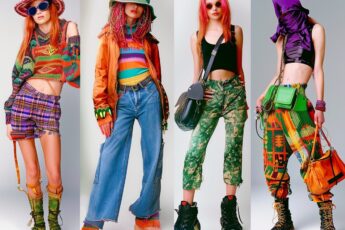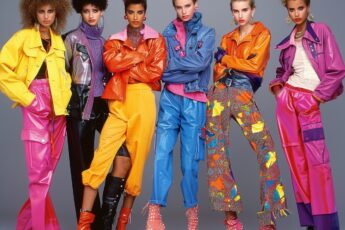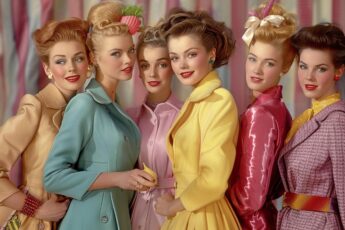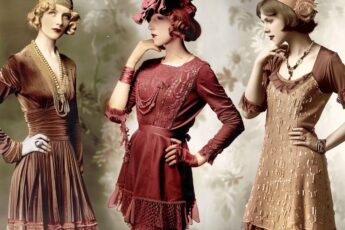The Dynamic World of 1970s Fashion
When I think about 1970s fashion, I’m instantly transported to a vibrant era of self-expression and creativity. This decade saw a remarkable transformation in how people dressed, reflecting the significant social and cultural changes of the time.
The 70s brought us a diverse range of styles, from the free-spirited hippie look to the glamorous disco scene. It was a time when fashion rules were meant to be broken, and individuality reigned supreme.
During this period, we witnessed the rise of synthetic fabrics, the popularization of unisex clothing, and the bold embrace of color and pattern. Designers pushed boundaries, and everyday people experimented with their personal style like never before.
Here’s a quick snapshot of key 1970s fashion elements:
- Bell-bottom jeans
- Platform shoes
- Polyester shirts
- Maxi dresses
- Fringe and tassels
The influence of music and popular culture on fashion was undeniable. Rock stars, actors, and other celebrities became style icons, inspiring millions to emulate their looks.
Fashion is not something that exists in dresses only. Fashion is in the sky, in the street; fashion has to do with ideas, the way we live, what is happening.
This quote perfectly encapsulates the spirit of 1970s fashion. It wasn’t just about the clothes; it was a reflection of the times, a visual representation of the decade’s ethos.
In the following chapters, we’ll delve deeper into the various aspects of 1970s fashion and explore how this incredible decade continues to influence style today. From hippie chic to disco fever, the 1970s left an indelible mark on the fashion world, and I’m excited to take you on this journey through time.
Hippie Influence on Mainstream Fashion
The hippie movement of the late 1960s left an indelible mark on 1970s fashion. I’ve always been fascinated by how this counterculture transformed mainstream style. Hippie fashion embraced natural fabrics, earth tones, and ethnic-inspired prints, creating a look that was both comfortable and visually striking.
Key elements of hippie-influenced 1970s fashion included:
- Flowing maxi dresses
- Embroidered denim
- Tie-dye patterns
- Fringed vests and jackets
- Headbands and flowers in hair
Natural fabrics like cotton and wool dominated hippie-inspired clothing. These materials aligned with the movement’s emphasis on getting back to nature and rejecting synthetic materials. Earth tones such as brown, beige, and muted greens reflected this natural aesthetic.
Ethnic-inspired prints added vibrancy to the hippie look. I’ve seen incredible examples of clothing featuring Indian paisley patterns, Native American motifs, and African tribal designs. These prints celebrated cultural diversity and global consciousness.
Fashion is a language that creates itself in clothes to interpret reality.
This quote perfectly captures the essence of hippie fashion in the 1970s. The clothes spoke volumes about the wearer’s values and worldview.
Rise of Disco Style
As the 1970s progressed, the disco era emerged, bringing with it a completely different fashion aesthetic. Disco style was all about glamour, glitter, and dancing all night. This look contrasted sharply with the earthy hippie vibe, embracing synthetic fabrics and bold, flashy designs.
Disco fashion staples included:
- Sequined dresses and tops
- Satin shirts for men
- Platform shoes
- Hot pants
- Jumpsuits
The fabrics used in disco fashion were often shiny and eye-catching. Lurex, a metallic yarn, added sparkle to many disco outfits. Polyester became hugely popular due to its durability and ease of care – perfect for long nights on the dance floor.
Footwear in the disco era was all about platform shoes. Both men and women sported these towering heels, which could add several inches to one’s height. I remember seeing platform boots with heels as high as four or five inches!
Here’s a quick comparison of hippie and disco styles:
| Hippie Style | Disco Style |
|---|---|
| Natural fabrics | Synthetic materials |
| Earth tones | Bright colors and metallics |
| Loose, flowing silhouettes | Tight-fitting, body-conscious shapes |
| Handcrafted accessories | Glittery, mass-produced jewelry |
| Bare feet or sandals | Platform shoes |
Clothes are like a good meal, a good movie, great pieces of music.
This quote resonates with the disco fashion philosophy. Disco clothing was meant to be fun, expressive, and larger than life – just like the music that inspired it.
Denim’s Evolution
The 1970s saw denim undergo a remarkable transformation. Bell-bottom jeans became the defining silhouette of the decade. These jeans started slim at the waist and thighs, then dramatically flared out from the knee down. I’ve seen bell-bottoms so wide you could barely see the wearer’s shoes!
Denim didn’t stop at jeans. Denim jackets rose to prominence, often adorned with patches, embroidery, or creative distressing. People wore these jackets with everything from t-shirts to dresses, making them a versatile staple of 70s wardrobes.
Key features of 1970s denim fashion:
- High-waisted fits
- Extreme flares
- Embroidered details
- Patchwork designs
- Stone-washed finishes
The evolution of denim in the 70s reflected broader cultural shifts. Embroidered details often featured peace signs, flowers, or other symbols of the counterculture movement. Patchwork designs showcased a DIY ethic and appreciation for handcrafted elements.
Denim is a love that never fades.
This quote captures the enduring appeal of denim, which only grew stronger throughout the 1970s. Denim became more than a fabric; it was a canvas for personal expression.
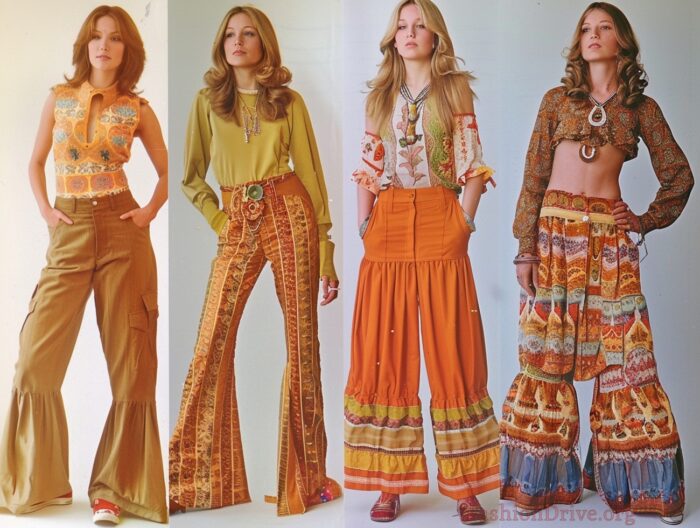
Bohemian Chic
Bohemian chic, or boho style, emerged as a softer, more romantic take on hippie fashion. This look embraced flowing silhouettes, natural fabrics, and a mix of vintage and ethnic-inspired elements. Boho chic in the 1970s exuded a carefree, artistic vibe that many found irresistible.
Central to the boho chic look were:
- Maxi dresses
- Peasant blouses
- Fringe accessories
- Layered jewelry
- Earth-toned suede
Maxi dresses epitomized the boho aesthetic. These ankle-length dresses often featured floral prints or paisley patterns. They could be belted at the waist or left loose for a more relaxed look.
Peasant blouses, with their loose fits and elaborate embroidery, paired well with both skirts and jeans. These tops often incorporated elements from traditional Eastern European or Mexican clothing.
Here’s how bohemian chic compared to mainstream fashion of the time:
| Bohemian Chic | Mainstream Fashion |
|---|---|
| Flowy silhouettes | Structured shapes |
| Natural, muted colors | Bold, synthetic hues |
| Handcrafted accessories | Mass-produced jewelry |
| Mixed patterns and textures | Uniform, matching outfits |
| Emphasis on individuality | Following trends |
Style is a way to say who you are without having to speak.
This quote perfectly encapsulates the bohemian chic philosophy. The eclectic, personal nature of the boho style allowed wearers to express their individuality through their clothing choices.
Fringe played a significant role in boho accessories. Bags, jackets, and even dresses featured fringe details, adding movement and a touch of drama to outfits. I’ve seen vintage photos of incredible fringed suede jackets that epitomize 70s boho cool.
Glam Rock Aesthetics
The 1970s saw the rise of glam rock, a music genre that brought with it a distinctive and flamboyant fashion style. Glam rock aesthetics challenged traditional gender norms and embraced theatricality in everyday wear. This look was all about standing out and making a statement.
Key elements of glam rock fashion included:
- Androgynous silhouettes
- Platform boots
- Glittery makeup
- Metallic fabrics
- Bold, colorful hair
Glam rockers often blurred the lines between masculine and feminine dress. Men wore makeup, platform heels, and tight-fitting clothes, while women adopted more traditionally masculine styles. This gender-bending approach to fashion was revolutionary for its time.
Metallic fabrics played a crucial role in the glam rock style. Shimmering materials like lamé, lurex, and sequins added a futuristic edge to outfits. I’ve seen incredible vintage photos of glam rock stars dressed head-to-toe in silver or gold, looking like they stepped out of a sci-fi movie.
Fashion is the armor to survive the reality of everyday life.
This quote perfectly encapsulates the escapist nature of glam-rock fashion. By donning these outrageous outfits, people could transform themselves and transcend the mundane.
Makeup became an essential part of the glam rock look for both men and women. Bold eyeshadows, glitter, and dramatic eyeliner were common. David Bowie’s iconic lightning bolt face paint epitomized this trend, inspiring countless imitations.
Punk Fashion Emergence
As the 1970s progressed, punk fashion emerged as a rebellious counterpoint to the excesses of glam rock and disco. The punk style was raw, aggressive, and intentionally shocking. It reflected the anger and disillusionment of youth culture during a time of economic and social upheaval.
Punk fashion staples included:
- Leather jackets
- Ripped clothing
- Safety pins as accessories
- Band T-shirts
- Studded accessories
Punk rejected the polish and glamour of mainstream fashion. Instead, it embraced a DIY ethic, with many punks customizing their own clothes. Rips, tears, and safety pins weren’t flaws – they were deliberate style choices.
Here’s a comparison between glam rock and punk aesthetics:
| Glam Rock | Punk |
|---|---|
| Colorful and shiny | Dark and distressed |
| Theatrical and flamboyant | Raw and aggressive |
| Expensive materials | DIY and secondhand |
| Androgynous | Anti-fashion |
| Elaborate makeup | Minimal, harsh makeup |
Fashion is not about perfection. It’s about an attitude.
This quote captures the essence of punk fashion. Punks weren’t trying to look perfect or polished – they were expressing an attitude of rebellion and nonconformity through their clothes.
Leather jackets, often adorned with studs, patches, or hand-painted designs, became iconic in punk fashion. These jackets served as a canvas for personal expression and a symbol of toughness. I’ve seen vintage punk jackets that tell entire stories through their accumulated decorations.
Punk makeup stood in stark contrast to the glittery looks of glam rock. Punk makeup was often minimal, with dark eyeliner and pale foundation creating a stark, almost ghostly appearance. Some punks experimented with unconventional hair colors and spiky styles, further setting themselves apart from mainstream society.
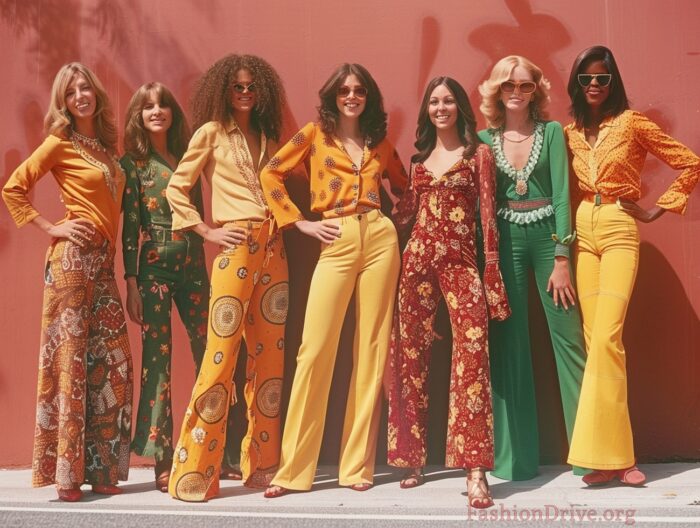
Sportswear as Everyday Attire
The 1970s marked a significant shift in how people viewed and wore sportswear. Athletic clothing broke free from the confines of gyms and sports fields, becoming a staple in everyday fashion. This trend reflected a growing interest in fitness and a more casual approach to dressing.
Key sportswear items that gained popularity included:
- Tracksuits
- Tennis shoes
- Sweatbands
- Athletic shorts
- Baseball caps
Tracksuits emerged as versatile outfits for exercise and leisure. Made from comfortable, breathable fabrics like cotton or polyester, they came in a variety of colors and designs. I’ve seen vintage photos of people wearing tracksuits to run errands or even out to casual dinners.
Tennis shoes transitioned from the court to the street. Brands like Nike and Adidas gained immense popularity, with their boots becoming fashion statements in their own right. People paired these comfortable sneakers with jeans, dresses, and everything in between.
Comfort is the ultimate luxury.
This quote encapsulates the sportswear trend of the 1970s. People increasingly valued comfort and functionality in their clothing choices without sacrificing style.
Sweatbands, both for the head and wrists, became trendy accessories. Often worn in bright colors, they served a practical purpose for athletes and added a sporty touch to casual outfits.
The influence of sports on 1970s fashion extended beyond clothing. Hairstyles like the sweatband-tamed afro and the tennis headband look became popular, further blurring the lines between athletic and everyday style.
Synthetic Fabrics Revolution
The 1970s witnessed a revolution in textile technology, with synthetic fabrics taking center stage in fashion. These man-made materials offered new possibilities in terms of texture, color, and care, changing the way people approached clothing.
Prominent synthetic fabrics of the era included:
- Polyester
- Nylon
- Acrylic
- Spandex
- Rayon
Polyester became particularly ubiquitous. Its wrinkle-resistant properties and easy care made it a favorite for both casual and formal wear. I’ve examined vintage polyester shirts with vibrant patterns that have retained their color and shape decades later.
Here’s a comparison of natural vs synthetic fabrics in 1970s fashion:
| Natural Fabrics | Synthetic Fabrics |
|---|---|
| Cotton, Wool, Silk | Polyester, Nylon, Acrylic |
| Breathable | Often less breathable |
| Wrinkle easily | Wrinkle-resistant |
| Muted colors | Vibrant, long-lasting colors |
| Higher maintenance | Easy care |
Innovation distinguishes between a leader and a follower.
This quote reflects the pioneering spirit of designers and manufacturers who embraced synthetic fabrics, pushing the boundaries of what was possible in fashion.
The rise of synthetic fabrics also enabled new techniques in textile production. Screen printing became more common, allowing for complex, colorful patterns on fabrics. This led to the bold, eye-catching designs that we now associate with 1970s fashion.
Spandex, known for its stretchiness, found its way into various garments. It allowed for tighter-fitting clothes that still provided comfort and ease of movement. This material was particularly popular in disco fashion, enabling the skin-tight looks that defined the era.
While synthetic fabrics had their critics, their impact on 1970s fashion was undeniable. They opened up new possibilities in design, durability, and affordability, democratizing fashion in ways that continue to influence how we dress today.
Unisex Clothing Trends
The 1970s saw a significant shift towards unisex clothing, blurring the lines between traditionally male and female attire. This trend reflected the era’s progressive attitudes towards gender roles and self-expression. Unisex fashion allowed people to experiment with their personal style without being confined by gender norms.
Key unisex items that gained popularity include:
- Jumpsuits
- Turtlenecks
- Pantsuits
- Denim jackets
- Flared trousers
Jumpsuits emerged as a versatile unisex garment. These one-piece wonders came in various styles, from utilitarian workwear to glamorous evening attire. I’ve seen vintage photos of both men and women rocking jumpsuits at Studio 54, epitomizing 70s cool.
Turtlenecks became a unisex staple, often paired with blazers or worn on their own. They offered a sleek, modern look that appealed to both genders. The simplicity of a black turtleneck, for instance, allowed it to be styled in countless ways.
Fashion is about dressing according to what’s fashionable. Style is more about being yourself.
This quote captures the essence of unisex fashion in the 70s. It wasn’t about conforming to trends but about expressing oneself freely.
Pantsuits, once considered strictly menswear, gained popularity among women. Designers like Yves Saint Laurent championed this look, creating elegant suits that challenged traditional notions of femininity.
Here’s a comparison of typical gendered vs unisex clothing items:
| Traditional Men’s Wear | Traditional Women’s Wear | Unisex Items |
|---|---|---|
| Suits | Dresses | Jumpsuits |
| Neckties | Skirts | Turtlenecks |
| Oxford shoes | High heels | Platform shoes |
| Dress shirts | Blouses | T-shirts |
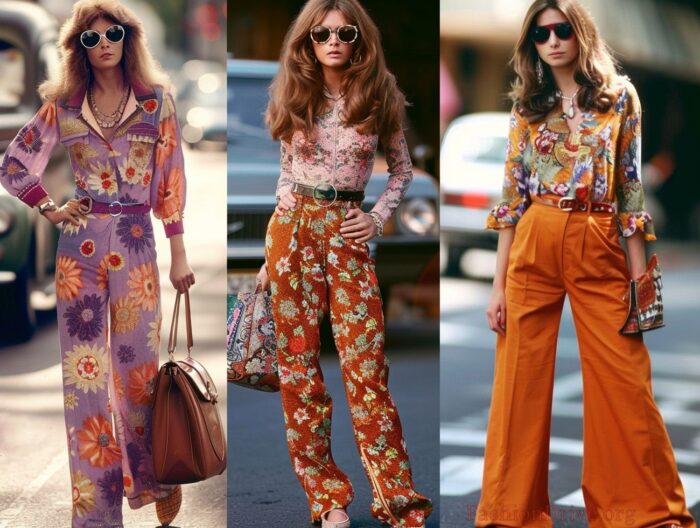
Accessories and Jewelry
The 1970s were a golden age for bold accessories and statement jewelry. These elements played a crucial role in completing the iconic looks of the decade. From oversized sunglasses to chunky platforms, accessories in the 70s were all about making a statement.
Popular accessories of the era included:
- Chunky platform shoes
- Oversized sunglasses
- Statement necklaces
- Wide belts
- Headbands
Platform shoes reached new heights in the 70s, quite literally. Both men and women sported these towering shoes, which could add several inches to one’s height. I’ve examined vintage platforms with soles as thick as four inches!
Sunglasses grew to epic proportions. Oversized frames in various shapes – from round to square to aviator – shielded eyes and added mystery to any outfit. These weren’t merely for sun protection; they were fashion statements in their own right.
Accessories are what, in my opinion, pull the whole look together and make it unique.
This quote underscores the importance of accessories in 70s fashion. They weren’t afterthoughts but integral parts of an outfit.
Jewelry in the 70s was bold and eye-catching. Statement necklaces, often featuring large pendants or multiple strands, adorned necks. Hoop earrings grew to impressive sizes, framing faces and adding movement to hairstyles.
Here’s a quick look at how accessories evolved from the 60s to the 70s:
| 1960s Accessories | 1970s Accessories |
|---|---|
| Pillbox hats | Floppy wide-brimmed hats |
| Kitten heels | Platform shoes |
| Thin belts | Wide belts |
| Delicate jewelry | Chunky, statement pieces |
| Cat-eye sunglasses | Oversized, round sunglasses |
Wide belts cinched waists and added definition to the flowing silhouettes popular in the 70s. These belts often featured large buckles or intricate designs, becoming focal points of outfits.
Headbands, from simple elastic bands to ornate, embellished pieces, kept hair in check while adding a bohemian touch to many looks. They paired particularly well with the long, straight hairstyles popular during this era.
Hair and Makeup Trends
The 1970s revolutionized hair and makeup, introducing styles that continue to influence modern beauty trends. This decade embraced both natural looks and bold experimentation, reflecting the diverse fashion movements of the era.
Key hair trends of the 70s included:
- Feathered hair
- Afros
- Long, straight styles
- Shags
- Mullets
Feathered hair, popularized by Farrah Fawcett, became an iconic 70s look. This style featured layers that turned outward, creating a soft, windswept effect. I’ve analyzed numerous photos from this era, and the volume and movement of feathered hair never fail to impress me.
Afros gained mainstream popularity, celebrating natural Black hair textures. This style ranged from small, well-groomed afros to large, statement-making ones. It symbolized pride and self-expression for many African Americans.
Makeup in the 70s varied widely, from barely-there natural looks to dramatic disco styles:
- Natural, dewy skin
- Shimmery eyeshadows
- Nude lips
- Dramatic false eyelashes
- Bold blush
Beauty begins the moment you decide to be yourself.
This quote encapsulates the ’70s approach to beauty. Whether opting for a natural look or full disco glamour, self-expression was key.
Here’s a comparison of early 70s vs late 70s makeup trends:
| Early 70s Makeup | Late 70s Makeup |
|---|---|
| Minimal foundation | Full coverage foundation |
| Earth-toned eyeshadows | Bright, shimmery eyeshadows |
| Thin eyeliner | Thick, winged eyeliner |
| Pale lipstick | Bold lip colors |
| Subtle blush | Prominent blush |
Influential Designers
The 1970s saw several designers rise to prominence, shaping the decade’s fashion landscape with their innovative creations. These designers pushed boundaries, introduced new styles, and left a lasting impact on the fashion world.
Some of the most influential designers of the 70s were:
- Yves Saint Laurent
- Halston
- Diane von Furstenberg
- Vivienne Westwood
- Bill Gibb
Yves Saint Laurent revolutionized women’s fashion by introducing traditionally masculine elements into womenswear. His le-smoking tuxedo suit for women challenged gender norms and became an instant classic. YSL also popularized the peasant look, drawing inspiration from ethnic and historical costumes.
Halston defined American luxury in the 70s with his minimalist, elegant designs. His signature Ultrasuede shirtdress and flowing caftan became staples of 70s fashion. I’ve studied Halston’s work extensively, and his ability to create simple yet sophisticated pieces never ceases to amaze me.
Fashion fades, style is eternal.
This quote reflects the enduring influence of these designers, whose work transcended the trends of the 70s and continues to inspire today.
Diane von Furstenberg introduced the wrap dress in 1974. This design combined comfort, femininity, and versatility. It became a symbol of women’s liberation and remains popular today.
Here’s a brief overview of these designers’ signature styles:
| Designer | Signature Style |
|---|---|
| Yves Saint Laurent | Le smoking suit, peasant blouses |
| Halston | Ultrasuede shirtdress, caftans |
| Diane von Furstenberg | Wrap dress |
| Vivienne Westwood | Punk aesthetic, tartan |
| Bill Gibb | Romantic, medieval-inspired designs |
Vivienne Westwood emerged as a key figure in punk fashion, bringing this rebellious style from the streets to the runway. Her use of unconventional materials and provocative designs challenged the fashion establishment.
These designers didn’t merely create clothes; they shaped the way people expressed themselves through fashion. Their influence extended beyond the 70s, cementing their place in fashion history.
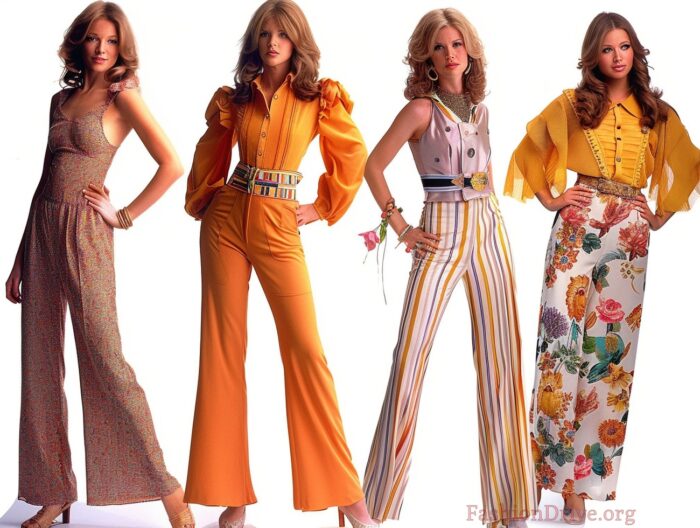
Celebrity Fashion Icons
The 1970s produced numerous celebrity fashion icons who significantly influenced the decade’s style trends. These figures, from musicians to actors, became trendsetters, inspiring millions with their unique and often daring fashion choices.
Notable fashion icons of the 70s included:
- David Bowie
- Farrah Fawcett
- Bianca Jagger
- Cher
- John Travolta
David Bowie stood out with his chameleon-like ability to transform his look. His Ziggy Stardust persona, with its flame-red hair and outlandish costumes, epitomized glam rock style. Bowie’s fashion choices blurred gender lines and pushed the boundaries of conventional style.
Thanks to her role in Charlie’s Angels, Farrah Fawcett became a beauty icon. Her feathered hairstyle was widely imitated, and her casual yet sexy approach to fashion resonated with many women. I’ve analyzed countless photos of Fawcett, and her effortless blend of athleticism and glamour never fails to impress.
Style is knowing who you are, what you want to say, and not giving a damn.
This quote encapsulates the bold, individualistic approach to fashion that these icons embodied.
Here’s a brief overview of these icons’ signature styles:
| Celebrity | Signature Style |
|---|---|
| David Bowie | Androgynous, glam rock |
| Farrah Fawcett | Feathered hair, casual chic |
| Bianca Jagger | Studio 54 glamour |
| Cher | Bohemian, revealing outfits |
| John Travolta | Disco king, white suit |
Bianca Jagger became synonymous with Studio 54 glamour. Her wedding to Mick Jagger, where she wore a white YSL smoking jacket, set the tone for her sophisticated yet daring style throughout the decade.
Cher’s fashion choices, often created by designer Bob Mackie, pushed the envelope with revealing, elaborately beaded outfits. Her bohemian off-stage style also influenced the fashion of the era.
Global Fashion Influences
The 1970s saw an increased interest in global fashion, with designers and consumers drawing inspiration from cultures around the world. This trend reflected a growing global consciousness and a desire for diverse, eclectic styles.
Key global influences on 70s fashion included:
- African prints
- Indian fabrics and embroidery
- Middle Eastern kaftan styles
- Native American motifs
- Japanese kimono-inspired designs
African prints, particularly bold geometric patterns and vibrant colors, found their way into mainstream Western fashion. These prints appeared on everything from dresses to accessories, adding a dynamic element to 70s style.
Indian influences were evident in the popularity of paisley patterns and embroidered details. The hippie movement’s fascination with Indian spirituality contributed to this trend. I’ve examined many vintage pieces featuring intricate Indian-inspired embroidery, showcasing the fine craftsmanship that was valued during this era.
Fashion has to reflect who you are, what you feel at the moment, and where you’re going.
This quote reflects how 70s fashion embraced diverse global influences to create personal, meaningful style statements.
Here’s how different global influences manifested in 70s fashion:
| Region | Fashion Influence |
|---|---|
| Africa | Bold prints, wooden jewelry |
| India | Paisley, embroidery, sari-inspired drapes |
| Middle East | Kaftans, metallic embellishments |
| Native America | Fringe, turquoise jewelry |
| Japan | Kimono-style wraps, obi belts |
Middle Eastern influences were seen in the popularity of kaftan-style tops and dresses. These loose, flowing garments aligned well with the decade’s bohemian aesthetic.
Native American-inspired elements, such as fringe details and turquoise jewelry, became fashionable. While appreciation of these elements has evolved, their impact on 70s fashion was significant.
This global approach to fashion opened up new possibilities for self-expression and contributed to the eclectic, diverse style landscape of the 1970s.
Conclusion
The 1970s fashion left an indelible mark on clothing history, influencing designers and styles for decades to come. This era saw an explosion of creativity, with diverse trends coexisting and often blending in unexpected ways. From hippie-inspired looks to disco glamour, from punk rebellion to bohemian chic, the 70s offered something for everyone.
Key takeaways from 1970s fashion include:
- Embrace of individuality
- The blurring of gender norms
- Incorporation of global influences
- Rise of synthetic fabrics
- Influence of music subcultures
The decade’s fashion reflected broader social changes, including women’s liberation, the civil rights movement, and growing environmental awareness. These shifts manifested in clothing choices, hairstyles, and accessories.
Fashion is the armor to survive the reality of everyday life.
This quote encapsulates how 70s fashion served as a form of self-expression and empowerment. People used clothing to communicate their values, beliefs, and identities.
The legacy of 1970s fashion continues to inspire contemporary designers and fashion enthusiasts. Many trends from this era have seen revivals or reinterpretations in recent years. Bell-bottom jeans, platform shoes, and bohemian prints regularly resurface on runways and in street style.
As I reflect on the fashion of the 1970s, I’m struck by its diversity and creativity. This decade taught us that fashion can be a powerful tool for self-expression and social commentary. The lessons of 70s style – embrace individuality, challenge norms, and draw inspiration from diverse sources – remain relevant in today’s fashion landscape.
